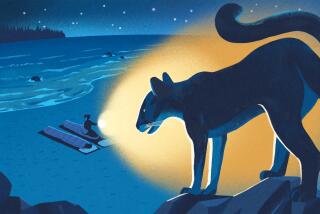Indians Keep Track of Mountain Lions on Colorado Reservation
- Share via
IGNACIO, Colo. — Mountain lions may be one of the most feared and elusive predators of southwest Colorado, but a crew of scientists on the Southern Ute Indian Reservation has been persistently searching for the wildcats since January.
The tribe is studying the dynamics of the mountain lion population on the reservation to develop a management plan that will determine if the population can sustain a hunting season, and if so, what the harvest limit should be and when the season should take place, according to Joe Koloski, a graduate student from the University of Wyoming, who is heading the study.
The reservation was opened to mountain lion hunting in 1992, but was closed after the 1997 winter season, Koloski said. Non-tribal members killed 18 mountain lions on the reservation during the 1992 and 1993 hunting seasons. After 1993, only tribal members were allowed to hunt the cats, he said.
Tribal members were killing an average of two lions per year, according to Terry Stroh, the head of the tribe’s Division of Wildlife Resource Management.
Koloski said the level of killing caused some concern within the wildlife department, because it wasn’t known if such hunting was sustainable.
“They didn’t really know what they were doing to the population,” he said.
The tribe then initiated the study to determine the population density of lions on the reservation, which covers 681,306 acres.
Stroh said he does not know how much the study is costing.
Other goals of the study are to determine the mountain lions’ pattern of reproduction and the survival rates of adult mountain lions, Koloski said.
To track a mountain lion, the crew first drives slowly through the reservation’s back roads, looking for tracks. Then they use specially trained dogs to pick up the lion’s scent and chase it down.
*
Koloski said it is much easier to track animals when there is snow on the ground, because the tracks are more visible and the snow holds a scent better. Once the dogs catch a lion’s scent, it normally doesn’t take them long to chase the lion up a tree, Koloski said.
The crew then shoots the lion with an immobilizing dart and ties the dogs back to allow the lion an escape route. Lions that have been shot normally don’t feel comfortable in the tree anymore, Koloski said, so they take advantage of their escape route and leave.
Within about 10 minutes of being shot by the dart, however, the lion’s muscles relax beyond use and an anesthetic knocks the animal unconscious, Koloski said.
*
After the lion passes out, the crew has about two hours to go about their work. While the lion is unconscious, they harness it with a radio collar, tag its ear, tattoo its inner lip with an identification number, estimate its age and record general observations on its health and reproductive status, Koloski said.
Once an animal is collared, the crew can locate its position on weekly flights over the reservation and bordering areas. Each collar has a different radio signal, distinguishing it from the others.
Since January, the mountain lion crew, made up of Koloski; the tribe’s wildlife biologist, Sam Diswood; two full-time wildlife technicians; and bison manager Chris Olguin, has tagged eight mountain lions.
Of the tagged lions, there are three adult females, one adult male, three sub-adult females and one sub-adult male. Lions under 4 years old are characterized as sub-adults, Koloski said.
Three of the adult female cats have had kittens, although the crew has only been able to locate and view two of the litters. The crew does not tag the kittens.
“Our goal is to put out around 20 collars,” Koloski said. “We’ll continue with our capture effort throughout the winter and hopefully get that done.”
Using the radio telemetry system, Koloski said he can construct a home range for the animals, or a pattern of the land they cover on or off the reservation.
Specifically, the crew wants to find out if the lions are staying on the reservation year-round or if they are following the deer and elk that head south during the winter.
“If part of your population leaves after you have an estimate, that effectively cuts the population down,” Koloski explained. “We don’t want to over-harvest these animals, because once they leave the reservation they’re subject to harvest in Colorado and New Mexico as well.”
The lions’ home range depends on the amount of prey available, Koloski said. One of the adult males on the reservation has a home range of 200 square miles.
Koloski said his crew does not have an estimate of the reservation’s mountain lion population at this point. The secretive and solitary nature of mountain lions, combined with the fact that the animals are active at night, makes finding them particularly difficult.
Although there are definitely mountain lions in the area, chances are you won’t ever see one.
“I’ve never seen one that wasn’t in a tree or wearing a collar, and I go out every day looking for them,” Koloski said. “Very few people see them in the wild.”
More to Read
Sign up for Essential California
The most important California stories and recommendations in your inbox every morning.
You may occasionally receive promotional content from the Los Angeles Times.










